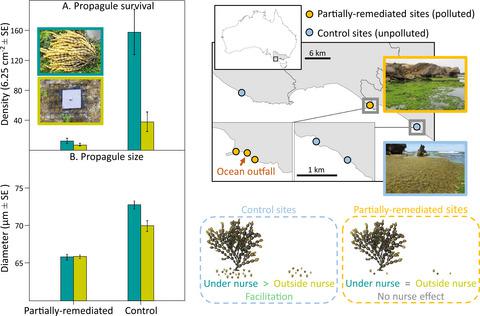当前位置:
X-MOL 学术
›
J. Appl. Ecol.
›
论文详情
Our official English website, www.x-mol.net, welcomes your
feedback! (Note: you will need to create a separate account there.)
Barriers to restoration: Pollution alters nurse effects for an ecosystem engineer
Journal of Applied Ecology ( IF 5.0 ) Pub Date : 2021-08-28 , DOI: 10.1111/1365-2664.14010 Hayley Cameron 1, 2 , Michael D. Amor 3, 4 , Alecia Bellgrove 1
中文翻译:

恢复障碍:污染改变了生态系统工程师的护士效应
更新日期:2021-08-28
Journal of Applied Ecology ( IF 5.0 ) Pub Date : 2021-08-28 , DOI: 10.1111/1365-2664.14010 Hayley Cameron 1, 2 , Michael D. Amor 3, 4 , Alecia Bellgrove 1
Affiliation

|
- Nurse plants modify the environment beneath their canopies to create favourable habitats for propagule recruitment. Nurse plants are potentially valuable tools for ecological restoration—yet empirical tests, particularly in polluted environments, remain rare.
- The few studies that do exist find that nurse plants positively affect propagule recruitment in polluted environments. Yet most tests have focused on pollution-tolerant species in metal-contaminated environments. Biotic interactions are highly context dependent, however, such that extrapolations to other suites of species and pollutant types appear premature.
- We examined changes in intraspecific nurse effects across pollution regimes for a pollution-sensitive, macroalgal ecosystem engineer that is a target for intertidal restoration. In a manipulative field experiment, we out-planted propagules in the presence and absence of conspecific canopies at unpolluted control shores and shores that received a partly remediated (low-toxicity) sewage effluent. We then monitored the performance (survival and growth) of these propagules over time.
- Algal canopies facilitated the survival and early growth of propagules at control sites, but not at partially remediated sites where propagules performed poorly irrespective of canopy presence.
- Synthesis and applications. Using a pollution-sensitive, macroalgal ecosystem engineer, we show for the first time that nurse-plant effects can be contingent on pollution regime, and that exposure to pollution (even at low levels) can erode nurse effects. We caution that nurse plants are unlikely to be universal tools for ecological restoration, including systems where facilitative nurse effects naturally occur (in our case, macroalgal canopies on unpolluted rocky reefs). Management practitioners should carefully consider the disturbance (e.g. pollution) tolerance of target species, and test whether nurse effects are maintained under current disturbance regimes, before large-scale translocations are attempted.
中文翻译:

恢复障碍:污染改变了生态系统工程师的护士效应
- 护士植物改变其冠层下的环境,为繁殖体募集创造有利的栖息地。护士植物是生态恢复的潜在有价值的工具——但经验测试,特别是在污染环境中,仍然很少见。
- 确实存在的少数研究发现,护理植物对污染环境中的繁殖体补充产生积极影响。然而,大多数测试都集中在金属污染环境中的耐污染物种。然而,生物相互作用高度依赖于环境,因此对其他物种和污染物类型的推断似乎为时过早。
- 我们研究了污染敏感的大型藻类生态系统工程师在污染制度中的种内护理效应的变化,该工程师是潮间带恢复的目标。在操纵性田间试验中,我们在未受污染的对照海岸和接受部分修复(低毒性)污水流出的海岸存在和不存在同种树冠的情况下外植繁殖体。然后,我们随着时间的推移监测了这些繁殖体的性能(存活和生长)。
- 藻冠促进了对照地点的繁殖体的存活和早期生长,但在部分修复的地点,无论冠层是否存在,繁殖体都表现不佳。
- 合成与应用。使用污染敏感的大型藻类生态系统工程师,我们首次表明护理植物效应可能取决于污染状况,并且暴露于污染(即使是低水平)会削弱护理效应。我们警告说,护生植物不太可能成为生态恢复的通用工具,包括自然发生促进性护生作用的系统(在我们的例子中,未受污染的岩礁上的大型藻类树冠)。管理从业者应仔细考虑目标物种的干扰(例如污染)耐受性,并在尝试大规模易地之前测试在当前干扰机制下是否能维持保育效应。









































 京公网安备 11010802027423号
京公网安备 11010802027423号